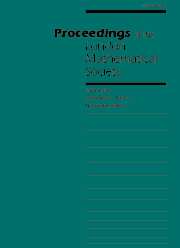Crossref Citations
This article has been cited by the following publications. This list is generated based on data provided by
Crossref.
Новиков, Дмитрий Петрович
and
Novikov, Dmitrii Petrovich
2006.
Интегральное преобразование решений уравнения фуксова класса.
Теоретическая и математическая физика,
Vol. 146,
Issue. 3,
p.
355.
Boalch, Philip
2006.
The fifty-two icosahedral solutions to Painlevé VI.
Journal für die reine und angewandte Mathematik (Crelles Journal),
Vol. 2006,
Issue. 596,
Qin, Huizeng
and
Lu, Youmin
2006.
On the asymptotics of the real solutions to the general sixthPainlevé equation.
International Journal of Mathematics and Mathematical Sciences,
Vol. 2006,
Issue. 1,
Kakei, Saburo
and
Kikuchi, Tetsuya
2006.
Aq-analogue of hierarchy andq-Painlevé VI.
Journal of Physics A: Mathematical and General,
Vol. 39,
Issue. 39,
p.
12179.
Novikov, D. P.
2006.
Integral transformation of solutions for a Fuchsian-class equation corresponding to the Okamoto transformation of the Painlevé VI equation.
Theoretical and Mathematical Physics,
Vol. 146,
Issue. 3,
p.
295.
Forrester, P J
and
Witte, N S
2006.
Random matrix theory and the sixth Painlevé equation.
Journal of Physics A: Mathematical and General,
Vol. 39,
Issue. 39,
p.
12211.
Kitaev, A V
and
Witte, N S
2007.
Boundary conditions for scaled random matrix ensembles in the bulk of the spectrum.
Journal of Physics A: Mathematical and Theoretical,
Vol. 40,
Issue. 42,
p.
12725.
Kakei, Saburo
and
Kikuchi, Tetsuya
2007.
The Sixth Painlevé Equation as Similarity Reduction of $${\widehat{\mathfrak{gl}}_3}$$ Generalized Drinfel’d–Sokolov Hierarchy.
Letters in Mathematical Physics,
Vol. 79,
Issue. 3,
p.
221.
Joshi, N.
Kitaev, A. V.
and
Treharne, P. A.
2007.
On the linearization of the Painlevé III–VI equations and reductions of the three-wave resonant system.
Journal of Mathematical Physics,
Vol. 48,
Issue. 10,
Iwasaki, Katsunori
and
Uehara, Takato
2007.
An ergodic study of Painlevé VI.
Mathematische Annalen,
Vol. 338,
Issue. 2,
p.
295.
Totaro, Burt
2007.
Euler and algebraic geometry.
Bulletin of the American Mathematical Society,
Vol. 44,
Issue. 4,
p.
541.
Boalch, Philip P.
2007.
Regge and Okamoto Symmetries.
Communications in Mathematical Physics,
Vol. 276,
Issue. 1,
p.
117.
Dettweiler, Michael
and
Reiter, Stefan
2007.
Painlevé equations and the middle convolution.
advg,
Vol. 7,
Issue. 3,
p.
317.
Гонцов, Ренат Равилевич
Gontsov, Renat Ravilevich
Побережный, Владимир Андреевич
and
Poberezhnyi, Vladimir Andreevich
2008.
Различные варианты проблемы Римана - Гильберта для линейных дифференциальных уравнений.
Успехи математических наук,
Vol. 63,
Issue. 4,
p.
3.
Takemura, Kouichi
2008.
Integral representation of solutions to Fuchsian system and Heun's equation.
Journal of Mathematical Analysis and Applications,
Vol. 342,
Issue. 1,
p.
52.
Poberezhny, Vladimir
2008.
On the Painlevé Property of Isomonodromic Deformations of Fuchsian Systems.
Acta Applicandae Mathematicae,
Vol. 101,
Issue. 1-3,
p.
255.
Iwasaki, Katsunori
2008.
Finite branch solutions to Painlevé VI around a fixed singular point.
Advances in Mathematics,
Vol. 217,
Issue. 5,
p.
1889.
Iwasaki, Katsunori
2008.
Algebraic Analysis of Differential Equations.
p.
143.
Chervov, Alexander
Falqui, Gregorio
and
Rybnikov, Leonid
2010.
Limits of Gaudin Algebras, Quantization of Bending Flows, Jucys–Murphy Elements and Gelfand–Tsetlin Bases.
Letters in Mathematical Physics,
Vol. 91,
Issue. 2,
p.
129.
Yamakawa, Daisuke
2011.
Middle convolution and Harnad duality.
Mathematische Annalen,
Vol. 349,
Issue. 1,
p.
215.


